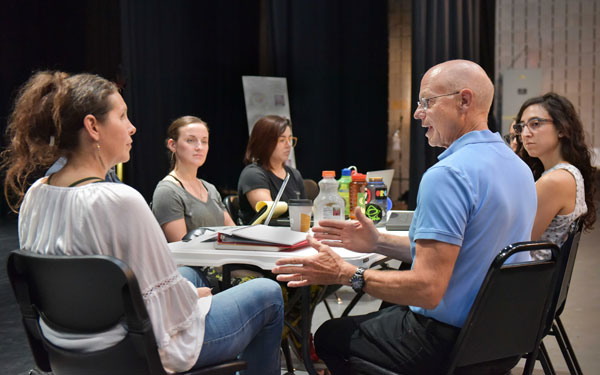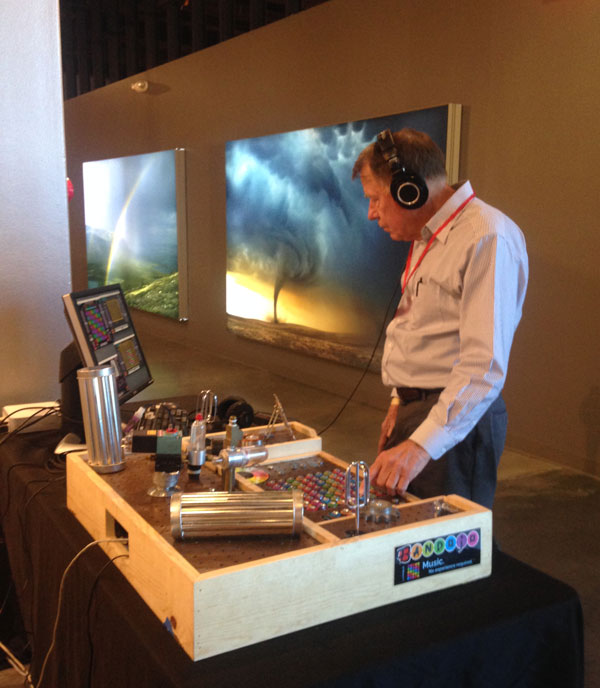Retirement means different things to different people. To Mike Murphy it wasn’t about TV and golf, not after logging 40 years as an electrical engineer in the nuclear weapons program at Sandia.
He wanted to put his experience to work.
Murphy, a manager in radar systems and firing sets, postponed retirement once.
“My time frame was to leave around 2001, then 9/11 happened,” he says. “There were things going on in the world that I wanted to contribute to. I couldn’t quit when we faced those challenges.”
He loved his work, and stayed at Sandia until 2009, then continued as a technical consultant. He also traveled and ran, from Albuquerque, his family’s cattle ranch in eastern New Mexico.
One day in 2017, he got a call from a former Sandia colleague, Ron Moya, who asked if he could help a local small business, PanMuse LLC, to develop a unique computer-based music system. He didn’t hesitate.
“It was right up my alley,” Murphy says. “I never wanted to be an idle retiree. I have a lot of knowledge and want to be useful. Helping a small company with a technical problem sounded like the right thing to do.”
He gave PanMuse a call.
Wealth of talent, need for help
Moya is a founder of Technology Retirees Economic Catalysts (TREC), established in 2015 to connect Sandia retirees with small businesses that need technical and other expertise. “A lot of intellectual capital leaves Sandia when people retire,” he says. “Many of them want to use their expertise to contribute.”
TREC was launched when Technology Ventures Corp. (TVC), a tech transfer nonprofit founded by former Sandia operator Lockheed Martin Corp. asked Moya, a retired mechanical engineer, to flesh out an idea he had to engage the Labs retiree community in economic development. Early encouragement came from Todd Hunter, a former Sandia staff member who was TVC’s chief financial officer and TREC’s first sponsor.
“I called a few of my friends and the ball got rolling,” Moya says.
His first call was to electrical engineer Larry Walker, the second to engineer Margie Tatro, then came HR specialist Barbara (BJ) Jones, engineer Art Ratzel, Hal Morgan, who worked in engineering sciences and tech transfer, and Murphy. Along with Hunter, they formed the TREC steering committee and developed a business plan. They built a network in the business community to introduce their service, sense the dynamics and get the word out.
“There’s an international concept called encore.org that talks about how, as people retire, there is a wealth of available talent and knowledge and a corresponding need for help in society,” Jones says. “How do we marry that? Retirees want to be relevant and give back to the community. When Ron called, I knew I wanted in.”
The steering committee is building a list of Sandia retirees willing to consult as volunteers with small businesses. “We’re a matchmaker,” Morgan says. “When a business needs help, we reach out to the Sandia retiree community and find someone.”
Join TREC and help a business
Sandia retirees interested in becoming TREC volunteers or in serving on the steering committee can call Ron Moya at 505-856-1245, Larry Walker at 505-294-4087 or Art Ratzel at 505-280-4720. The group also can be reached through its website.
Moya encourages Sandians who are planning to retire to join TREC.
A direct link to resources
When TVC closed last year, TREC found a new home and sponsor at the Women’s Economic Self Sufficiency Team, or WESST, a statewide nonprofit that offers consulting, training, lending and business incubation to people starting or growing a business. The self-sufficiency team serves thousands of clients a year and offers TREC meeting space, referrals and a website. “We are always looking for resources for our clients, and TREC is a great fit,” says Julianna Silva, managing director of the team’s Enterprise Center. “We share a lot of the same goals. The alliance gives our clients a direct link to the resources TREC brings to the community.”
Under the WESST umbrella, TREC does not have to be a certified nonprofit and is free to provide technical and business support without an administrative infrastructure. TREC volunteers pitch in as consultants, not employees. Their role is advisory, though they’ve been known to do some soldering or write some software.
“The objective is to keep a company on the right path, not be its forever engineer,” Moya says. “And we’re easy to work with. We can help almost on a handshake.”
Walker says Sandia retirees bring intellectual capital to the small-business community. Volunteers include experts in chemical, electrical and mechanical engineering, computer and materials science, physics and more. “These are people who have spent their careers working with the federal government and entities ranging from the Department of Defense to Goodyear Tire — you name it,” he says. “They understand the technology, the financials, the policy.”
‘I’ll take as much help as they can give’
Charles Harb, president of RingIR, an Albuquerque startup operating out of the WESST incubator, is developing a mobile laser-based technology that can immediately detect and identify gases for security, industry or research. His company is working with Sandia retiree Rick Ormesher on digital signal processing.
“I’m a quantum physicist, which is highly theoretical and completely different from RingIR, which is practical,” Harb says. “Rick is a professional with a wealth of knowledge. He has helped us immensely, including training our younger engineers. We talk about specific problems and how to deal with them. TREC is a great asset. I’ll take as much help as they can give.”
Ormesher, who retired two years ago after more than 30 years in radar analysis, says he likes staying engaged without the commitment of a 9-to-5 job.
“Charles needed somebody with my background, and when Ron called, I was happy to lend a hand,” Ormesher says. “Starting a company is tough, especially in technology. I can look at their methods and approaches and identify ways to improve things.”

Shira Greenberg, founder and artistic director of Keshet Dance and Center for the Arts in Albuquerque, asked TREC for help when she began developing a dance performance that would blend art and science. Her wish was granted in the person of Pace VanDevender, a renowned physicist, Sandia vice president emeritus and former director of pulsed power sciences at the Labs.
“I almost didn’t believe it when he walked in the door,” Greenberg says. “Who would have thought that we could work with a scientist of his stature on our dance project? It’s a unique and rare opportunity and just as amazing as you might imagine. This dream of ours will happen and will be fantastic because of him.”
VanDevender enjoys collaborating with the young artists and bringing a new dimension to his work in physics. “It’s an entirely new realm and way of thinking but it turns out the creative process is the same in science and dance: preparation, incubation, illumination and implementation,” he says. “It’s been a terrific experience for all of us.”
A different kind of customer
As TREC grows, Moya envisions an organization that is recognized in the small-business and startup communities as an R&D and business resource. He would like to involve retirees from other technical institutions and universities. “Sandia is where we started but membership isn’t limited,” he says.
“We’d like to be an organization that has helped people with their businesses and given volunteers the satisfaction of knowing they helped,” Morgan says.
Ratzel says entrepreneurs are different from normal Sandia customers. “It’s interesting work,” he says. “I love the idea of giving retirees a chance to stay engaged, see what’s going on, dust some cobwebs off the brain and make a difference.”
Sandia staff work for a mission-driven organization and bring that drive to retirement, Jones says. “That’s who we are,” she says. “We’re embedded with the notion of exceptional service in the national interest. The desire to contribute doesn’t go away with the flip of a switch. We want to have a purpose, have impact.”
Hunter says economic development is a new mission for Sandia retirees. “We’ve invested in this community and want it to be vibrant,” he says. “That means something to all of us.”
Mary Monson, senior manager of Technology Partnerships and Business Development, says TREC complements Sandia tech transfer efforts and provides a much-needed resource for local small businesses. “Several TREC members were involved in technology transfer at the Labs and continue to be passionate about helping companies succeed,” she says.
Becoming a better musician
PanMuse, the computer-based musical instrument company, is developing a system that lets people of varying physical and cognitive abilities play music simply by touching a screen. It might show a dinner setting, and music is made by touching goblets, plates, silverware and flowers.
“It’s an artful physical interface that is unexpected,” says PanMuse Chief Technology Officer Lisa Maynes. “We want to create entire interactive, immersive environments for driving music making.”
Maynes is a computer scientist and developed the PanMuse software. But there was no front-end system people could interact with to make the music. Maynes reached out to TREC and got help from Murphy and Walker, both electrical engineers, and manufacturing process engineer Phil Gallegos. They worked with Maynes to create the physical touch-sensing system.
“Larry, Michael and Phil were instrumental in making the capacitive touch-sensing robust,”

Mayes says. “They worked with us to understand the data filtering algorithms for the touch-sensing,like you’d use on a smartphone screen. They also helped in creating the right grounding and shielding for the systems and adding more filtering to the electronics we provided.
“It was a pleasure and a boon to work with them. They are superbly competent and generous — some of the best people we’ve ever worked with. Everything they did with us was critical to getting to the stage of manufacturing. We’re developing a new business plan that expands the scope of the company and we very much want them to be advisers.”
Murphy says it felt good to be part of the PanMuse business. “At Sandia, I was used to working with highly skilled technical people. At PanMuse, they really needed the help in electrical engineering.”
And there was a bonus. Murphy for years has played violin and mandolin in an Irish band but had no formal musical training. “Working with them has taught me a lot about music,” he says. “I’m a better musician now.”